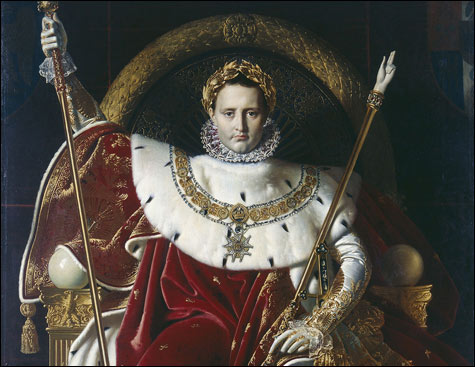Napoleon’s Empire style at the MFA
By JEFFREY GANTZ | October 16, 2007

NAPOLEON I ON HIS IMPERIAL THRONE: (1806) Ingres’s portrait presents the myth but not the
man. |
| “Symbols of Power: Napoleon and The Art of The Empire Style, 1800–1815” | Museum Of Fine Arts: October 21–January 27 |
“In four days I should have been in London . . . not as a conqueror, but as a liberator. I should have been another William III; but I would have acted with greater generosity and disinterestedness. . . . We would have presented ourselves to them, not as conquerors, but as brothers, who came to restore them to their rights and liberties.” That’s Napoleon Bonaparte speaking, after his hopes of rescuing the British Isles had been blighted by the British blockade and the Battle of Trafalgar. America, after all, had thrown off the yoke of George III a quarter-century earlier, so why not the British themselves? Of course, Napoleon also attempted to liberate Egypt, Spain, Italy, Austria, Germany, Russia, and numerous other countries, and though some did regard him as the bearer of freedom, most did not. A mere decade after the Revolution had guillotined thousands for the crime of enjoying privilege, however, France suffered Napoleon to crown himself as emperor. Who was this conundrum of charisma and contradiction? “Symbols of Power: Napoleon and the Art of the Empire Style, 1800–1815” — which, after opening at the St. Louis Art Museum, comes to the Museum of Fine Arts (it’ll finish its tour at the Musée des Arts Décoratifs in Paris) — looks at the Napoleonic riddle in the mirror of its art.He was, for starters, not French. He was born Napoleone di Buonaparte, in Corsica, in 1769, just one year after it was handed over to France, and though he learned French, at age nine, in order to be admitted to a military school near Troyes, he never spoke it without an Italian accent. Having distinguished himself during the Revolution, notably in quelling risings in Toulon and Paris, he won the favor of the ruling Directory and was given command of the French army in Italy. After successes there and in Egypt, he led the military coup that overthrew the Directory, and though at first he was only one of three consuls heading the new government, he secured his election as first consul. An assassination plot (charged to the Bourbons) enabled him to demand he be named emperor, to forestall further efforts at a Bourbon restoration.
The coronation took place, in the enforced presence of Pope Pius VII, on December 2, 1804. Over the next 10 years, Napoleon waged war — ostensibly in defense of the Revolution — against most of Europe. But he was also one of the founders of the modern nation state: centralized, bureaucratic, patriotic. He promulgated the civil laws we know as the Napoleonic Code; he brought everything from banking and taxation to education and the sewer system under his control. He led hundreds of thousands of Frenchmen to their deaths; yet when he escaped from Elba in 1815 and returned to France, hundreds of thousands more followed him. He looked back, consciously, to Caesar Augustus and Charlemagne, and ahead to Hitler and Stalin.
 Related
Related:
The Empire strikes back, Turn on the bright lights, Gods and monsters — and David Hasselhoff, More 
- The Empire strikes back
Napoleon himself was well aware of the force that iconic images can have on the public imagination.
- Turn on the bright lights
Art this fall grapples with issues like gender and journalism, personal space and human survival, and what to have for lunch.
- Gods and monsters — and David Hasselhoff
The Museum of Fine Arts did big things with Napoleon and Edward Hopper, pictures of prostitutes graced the walls of Boston’s two biggest art museums, and all hell broke loose when the Mooninites invaded.
- Carry on
In Mexico, a woven textile that has long been used by women for carrying children and bundles, as well as for warmth and cover, is the focus of “The Rebozo: A Traditional Mexican Women’s Garment.”
- Voice of regeneration
Havens, who comes to the MFA this Sunday, has been following his muse since he was a child.
- Wandering star
Cleaning the kitchen of her Brooklyn apartment a few weeks ago — shortly before hitting the road in support of her fourth full-length, The Living and the Dead (Anti-) — singer-songwriter Jolie Holland was struck by an idea for her fifth album.
- Song of herself
"Listen, I will go on record saying I love Feist, I love Neko Case. I love that music. But that shit's easy listening for the twentysomethings. It fucking is. It's not hard to listen to any of that stuff."
- Visions of isolation
In Edward Hopper’s world, everyone is lost in an unending rut of office overtime, rattling El trains, cheap fluorescent diners, and bad dates.
- Cinema of suffering
Film, like most arts, tries to turn misery into entertainment.
- When worlds collide
We humans are quick to anthropomorphize the non-human.
- Your history
For a building, inclusion on the National Trust for Historic Preservation’s 11 Most Endangered list is a mixed blessing.
- Less

 Topics
Topics:
Museum And Gallery
, Culture and Lifestyle, Religion, Christianity, More  , Culture and Lifestyle, Religion, Christianity, Adolf Hitler, Nazi Party, Cultural Institutions and Parks, Museums, Museum of Fine Arts, King George III, Roman Catholicism, Less
, Culture and Lifestyle, Religion, Christianity, Adolf Hitler, Nazi Party, Cultural Institutions and Parks, Museums, Museum of Fine Arts, King George III, Roman Catholicism, Less 